Chegg What Is the Major Product Formed in the Following Reaction Again Assuming No Rearrangements
Chapter 9. Gases
ix.3 Stoichiometry of Gaseous Substances, Mixtures, and Reactions
Learning Objectives
Past the end of this section, you volition be able to:
- Utilize the ideal gas law to compute gas densities and molar masses
- Perform stoichiometric calculations involving gaseous substances
- Country Dalton'south police of fractional pressures and utilize it in calculations involving gaseous mixtures
The study of the chemical beliefs of gases was part of the basis of perhaps the most fundamental chemical revolution in history. French nobleman Antoine Lavoisier, widely regarded equally the "father of mod chemistry," changed chemistry from a qualitative to a quantitative science through his work with gases. He discovered the law of conservation of matter, discovered the office of oxygen in combustion reactions, determined the composition of air, explained respiration in terms of chemical reactions, and more. He was a prey of the French Revolution, guillotined in 1794. Of his decease, mathematician and astronomer Joseph-Louis Lagrange said, "It took the mob only a moment to remove his head; a century will not suffice to reproduce information technology."[1]
As described in an earlier chapter of this text, we can turn to chemical stoichiometry for answers to many of the questions that enquire "How much?" Nosotros can answer the question with masses of substances or volumes of solutions. Nonetheless, we tin also answer this question some other way: with volumes of gases. We tin can use the ideal gas equation to relate the force per unit area, volume, temperature, and number of moles of a gas. Here we will combine the platonic gas equation with other equations to find gas density and tooth mass. Nosotros will deal with mixtures of different gases, and calculate amounts of substances in reactions involving gases. This section will not introduce whatever new material or ideas, only will provide examples of applications and ways to integrate concepts we have already discussed.
Density of a Gas
Retrieve that the density of a gas is its mass to volume ratio, [latex]\rho = \frac{m}{Five}[/latex]. Therefore, if we can determine the mass of some book of a gas, nosotros volition get its density. The density of an unknown gas can used to determine its molar mass and thereby assist in its identification. The platonic gas law, PV = nRT, provides united states with a means of deriving such a mathematical formula to relate the density of a gas to its book in the proof shown in Example i.
Example 1
Derivation of a Density Formula from the Ideal Gas Police
Use PV = nRT to derive a formula for the density of gas in g/L
Solution
- PV = nRT
- Rearrange to get (mol/Fifty): [latex]\frac{due north}{v} = \frac{P}{RT}[/latex]
- Multiply each side of the equation by the molar mass, [latex]\mathcal{Grand}[/latex]. When moles are multiplied by [latex]\mathcal{M}[/latex] in one thousand/mol, chiliad are obtained:
[latex](\mathcal{Thou})(\frac{north}{V}) = (\frac{P}{RT})(\mathcal{M})[/latex] - [latex]g \text{/L} = \rho = \frac{P \mathcal{Thou}}{RT}[/latex]
Check Your Learning
A gas was plant to have a density of 0.0847 one thousand/L at 17.0 °C and a pressure of 760 torr. What is its molar mass? What is the gas?
Answer:
[latex]\rho = \frac{P \mathcal{M}}{RT}[/latex]
[latex]0.0847 \;\text{thou/L} = 760 \;\rule[0.5ex]{1.7em}{0.1ex}\hspace{-one.7em}\text{torr} \times \frac{1 \;\rule[0.25ex]{1.2em}{0.1ex}\hspace{-1.2em}\text{atm}}{760 \;\rule[0.25ex]{one.2em}{0.1ex}\hspace{-1.2em}\text{torr}} \times \frac{\mathcal{M}}{0.0821 \;\text{50} \;\dominion[0.25ex]{1.2em}{0.1ex}\hspace{-1.2em}\text{atm/mol One thousand}} \times 290 \;\text{Grand}[/latex]
[latex]\mathcal{Grand}[/latex] = 2.02 g/mol; therefore, the gas must be hydrogen (Hii, 2.02 k/mol)
We must specify both the temperature and the pressure level of a gas when computing its density because the number of moles of a gas (and thus the mass of the gas) in a liter changes with temperature or pressure level. Gas densities are oft reported at STP.
Instance 2
Empirical/Molecular Formula Issues Using the Platonic Gas Law and Density of a Gas
Cyclopropane, a gas once used with oxygen as a general anesthetic, is composed of 85.7% carbon and xiv.iii% hydrogen by mass. Discover the empirical formula. If ane.56 g of cyclopropane occupies a volume of 1.00 Fifty at 0.984 atm and 50 °C, what is the molecular formula for cyclopropane?
Solution
Strategy: Beginning solve the empirical formula problem using methods discussed earlier. Assume 100 g and convert the percentage of each element into grams. Determine the number of moles of carbon and hydrogen in the 100-yard sample of cyclopropane. Dissever past the smallest number of moles to relate the number of moles of carbon to the number of moles of hydrogen. In the terminal step, realize that the smallest whole number ratio is the empirical formula:
[latex]\begin{array}{l l}85.seven \;\text{one thousand C} \times \frac{1 \;\text{mol C}}{12.01 \;\text{thou C}} = vii.136 \;\text{mol C} & \frac{7.136}{7.136} = 1.00 \;\text{mol C} \\[1em] 14.3 \;\text{thou H} \times \frac{1 \;\text{mol H}}{1.01 \;\text{g H}} = 14.158 \;\text{mol H} & \frac{xiv.158}{7.136} = i.98 \;\text{mol H} \end{array}[/latex]
Empirical formula is CH2 [empirical mass (EM) of fourteen.03 g/empirical unit of measurement].
Next, use the density equation related to the platonic gas law to decide the molar mass:
[latex]\text{d} = \frac{P \mathcal{One thousand}}{RT} \;\;\;\;\; \frac{1.56 \;\text{g}}{one.00 \;\text{L}} = 0.984 \;\text{atm} \times \frac{\mathcal{K}}{0.0821 \;\text{Fifty atm/mol K}} \times 323 \;\text{K}[/latex]
[latex]\mathcal{Thou}[/latex] = 42.0 g/mol, [latex]\frac{\mathcal{M}}{\text{East} \mathcal{1000}} = \frac{42.0}{xiv.03} = 2.99[/latex], then (3)(CH2) = CthreeH6 (molecular formula)
Cheque Your LearningAcetylene, a fuel used welding torches, is comprised of 92.3% C and seven.7% H past mass. Notice the empirical formula. If 1.10 g of acetylene occupies of book of 1.00 L at i.fifteen atm and 59.v °C, what is the molecular formula for acetylene?
Answer:
Empirical formula, CH; Molecular formula, CtwoHtwo
Tooth Mass of a Gas
Another useful application of the ideal gas law involves the decision of molar mass. By definition, the molar mass of a substance is the ratio of its mass in grams, m, to its amount in moles, n:
[latex]\mathcal{Thou} = \frac{\text{grams of substance}}{\text{moles of substance}} = \frac{1000}{n}[/latex]
The platonic gas equation tin be rearranged to isolate n:
[latex]n = \frac{PV}{RT}[/latex]
and and so combined with the molar mass equation to yield:
[latex]\mathcal{Thou} = \frac{mRT}{PV}[/latex]
This equation can be used to derive the molar mass of a gas from measurements of its force per unit area, volume, temperature, and mass.
Example 3
Determining the Molar Mass of a Volatile Liquid
The estimate molar mass of a volatile liquid tin can be determined by:
- Heating a sample of the liquid in a flask with a tiny hole at the meridian, which converts the liquid into gas that may escape through the hole
- Removing the flask from heat at the instant when the concluding chip of liquid becomes gas, at which time the flask will be filled with only gaseous sample at ambient force per unit area
- Sealing the flask and permitting the gaseous sample to condense to liquid, and and so weighing the flask to determine the sample's mass (encounter Figure 1)

Using this procedure, a sample of chloroform gas weighing 0.494 k is collected in a flask with a volume of 129 cm3 at 99.vi °C when the atmospheric pressure is 742.i mm Hg. What is the approximate tooth mass of chloroform?
Solution
Since [latex]\mathcal{K} = \frac{m}{due north}[/latex] and [latex]northward = \frac{PV}{RT}[/latex], substituting and rearranging gives [latex]\mathcal{M} = \frac{mRT}{PV}[/latex],
then
[latex]\mathcal{M} = \frac{mRT}{PV} = \frac{(0.494 \;\text{g}) \times 0.08206 \;\text{L} \cdot \text{atm/mol Thousand} \times 372.8 \;\text{1000}}{0.976 \;\text{atm} \times \; 0.129 \;\text{L}} = 120 \;\text{thou/mol}[/latex]
Check Your Learning
A sample of phosphorus that weighs 3.243 × x−2 g exerts a force per unit area of 31.89 kPa in a 56.0-mL bulb at 550 °C. What are the molar mass and molecular formula of phosphorus vapor?
The Pressure level of a Mixture of Gases: Dalton's Law
Unless they chemically react with each other, the individual gases in a mixture of gases do non affect each other's pressure. Each private gas in a mixture exerts the same pressure that it would exert if it were present solitary in the container (Effigy 2). The pressure exerted by each individual gas in a mixture is called its partial force per unit area. This ascertainment is summarized by Dalton's law of partial pressures: The total pressure of a mixture of ideal gases is equal to the sum of the fractional pressures of the component gases:
[latex]P_{Total} = P_A + P_B + P_C + \cdots = \sum_{\text{i}} P_\text{i}[/latex]
In the equation PFull is the total pressure level of a mixture of gases, PA is the partial pressure level of gas A; PB is the fractional pressure of gas B; PC is the partial force per unit area of gas C; and and so on.
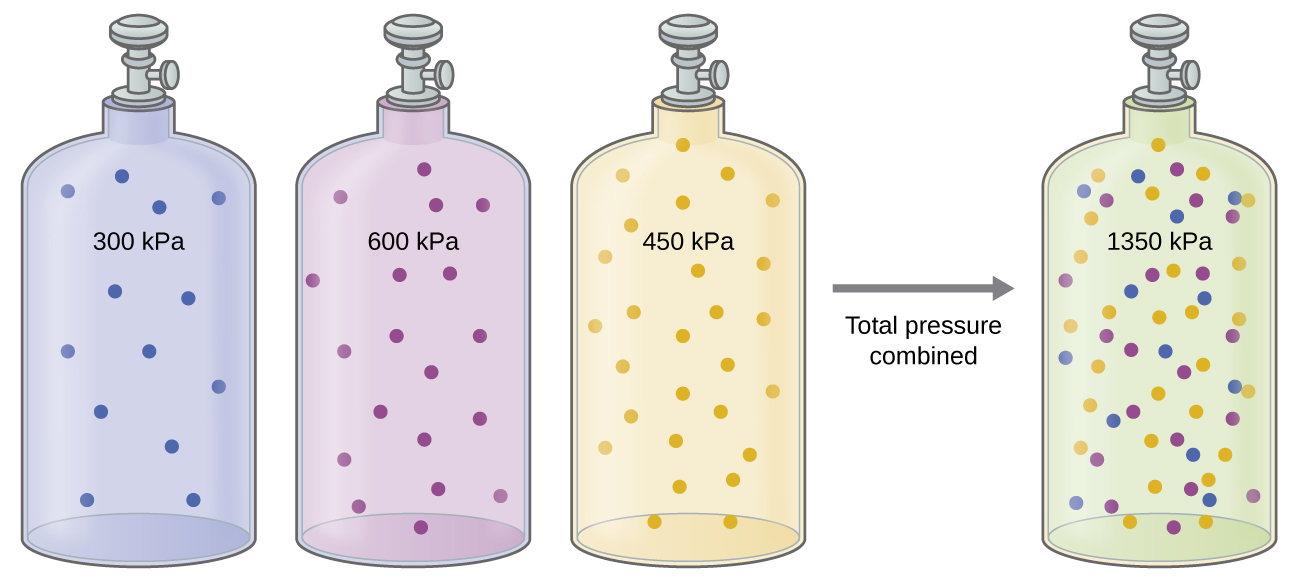
The partial pressure level of gas A is related to the total pressure of the gas mixture via its mole fraction (10), a unit of concentration defined every bit the number of moles of a component of a solution divided by the full number of moles of all components:
[latex]P_A = X_A \times P_{Full} \;\;\;\;\; \text{where} \;\;\;\;\; X_A = \frac{n_A}{n_{Total}}[/latex]
where PA , XA , and northA are the partial force per unit area, mole fraction, and number of moles of gas A, respectively, and nTotal is the number of moles of all components in the mixture.
Case iv
The Pressure level of a Mixture of Gases
A ten.0-50 vessel contains 2.50 × x−3 mol of H2, 1.00 × x−3 mol of He, and 3.00 × 10−iv mol of Ne at 35 °C.
(a) What are the partial pressures of each of the gases?
(b) What is the total force per unit area in atmospheres?
Solution
The gases behave independently, and then the partial force per unit area of each gas can exist adamant from the platonic gas equation, using [latex]P = \frac{nRT}{V}[/latex]:
[latex]P_{\text{H}_2} = \frac{(two.fifty \times ten^{-iii} \;\rule[0.5ex]{one.2em}{0.1ex}\hspace{-1.2em}\text{mol})(0.08206 \;\dominion[0.5ex]{0.5em}{0.1ex}\hspace{-0.5em}\text{50} \;\text{atm} \;\dominion[0.5ex]{three.5em}{0.1ex}\hspace{-3.5em}\text{mol}^{-1} \text{K}^{-ane})(308 \;\rule[0.5ex]{0.5em}{0.1ex}\hspace{-0.5em}\text{M})}{10.0 \;\rule[0.5ex]{0.5em}{0.1ex}\hspace{-0.5em}\text{Fifty}} = 6.32 \times 10^{-iii} \;\text{atm}[/latex]
[latex]P_\text{He} = \frac{(1.00 \times ten^{-iii} \;\rule[0.5ex]{1.2em}{0.1ex}\hspace{-ane.2em}\text{mol})(0.08206 \;\rule[0.5ex]{0.5em}{0.1ex}\hspace{-0.5em}\text{L} \;\text{atm} \;\rule[0.5ex]{iii.5em}{0.1ex}\hspace{-3.5em}\text{mol}^{-1} \text{K}^{-1})(308 \;\rule[0.5ex]{0.5em}{0.1ex}\hspace{-0.5em}\text{K})}{10.0 \;\rule[0.5ex]{0.5em}{0.1ex}\hspace{-0.5em}\text{L}} = 2.53 \times 10^{-iii} \;\text{atm}[/latex]
[latex]P_\text{Ne} = \frac{(3.00 \times 10^{-iv} \;\rule[0.5ex]{one.2em}{0.1ex}\hspace{-1.2em}\text{mol})(0.08206 \;\rule[0.5ex]{0.5em}{0.1ex}\hspace{-0.5em}\text{L} \;\text{atm} \;\rule[0.5ex]{three.5em}{0.1ex}\hspace{-three.5em}\text{mol}^{-ane} \text{K}^{-1})(308 \;\rule[0.5ex]{0.5em}{0.1ex}\hspace{-0.5em}\text{Yard})}{10.0 \;\dominion[0.5ex]{0.5em}{0.1ex}\hspace{-0.5em}\text{50}} = 7.58 \times 10^{-four} \;\text{atm}[/latex]
The total pressure is given by the sum of the partial pressures:
[latex]P_\text{T} = P_{\text{H}_2} + P_\text{He} + P_\text{Ne} = (0.00632 + 0.00253 + 0.00076) \;\text{atm} = 9.61 \times x^{-three} \;\text{atm}[/latex]
Check Your Learning
A five.73-L flask at 25 °C contains 0.0388 mol of Due north2, 0.147 mol of CO, and 0.0803 mol of Htwo. What is the total pressure in the flask in atmospheres?
Here is another example of this concept, but dealing with mole fraction calculations.
Example 5
The Pressure level of a Mixture of Gases
A gas mixture used for anesthesia contains ii.83 mol oxygen, O2, and 8.41 mol nitrous oxide, N2O. The total force per unit area of the mixture is 192 kPa.
(a) What are the mole fractions of O2 and N2O?
(b) What are the fractional pressures of O2 and N2O?
Solution
The mole fraction is given by [latex]X_A = \frac{n_A}{n_{Total}}[/latex] and the partial pressure is [latex]P_A = X_A \times P_{Total}[/latex].
For Otwo,
[latex]X_{O_2} = \frac{n_{O_2}}{n_{Total}} = \frac{2.83 \;\text{mol}}{(ii.83 + eight.41) \;\text{mol}} = 0.252[/latex]
and [latex]P_{O_2} = X_{O_2} \times P_{Total} = 0.252 \times 192 \;\text{kPa} = 48.4 \;\text{kPa}[/latex]
For N2O,
[latex]X_{N_2} = \frac{n_{N_2}}{n_{Total}} = \frac{8.41 \;\text{mol}}{(2.83 + viii.41) \;\text{mol}} = 0.748[/latex]
and
[latex]P_{N_2} = X_{N_2} \times P_{Total} = 0.748 \times 192 \;\text{kPa} = 143.6 \;\text{kPa}[/latex]
Check Your Learning
What is the pressure of a mixture of 0.200 g of H2, 1.00 chiliad of Northwardii, and 0.820 g of Ar in a container with a volume of 2.00 50 at xx °C?
Collection of Gases over Water
A simple mode to collect gases that practise non react with water is to capture them in a bottle that has been filled with water and inverted into a dish filled with water. The pressure of the gas inside the canteen can be fabricated equal to the air pressure level exterior by raising or lowering the bottle. When the water level is the aforementioned both inside and exterior the bottle (Figure 3), the pressure of the gas is equal to the atmospheric pressure, which can be measured with a barometer.
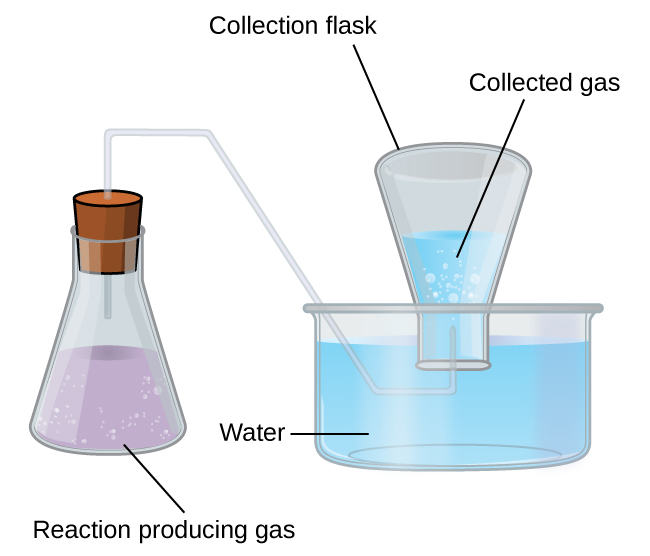
Yet, there is some other factor nosotros must consider when we measure the pressure of the gas past this method. H2o evaporates and in that location is always gaseous water (h2o vapor) in a higher place a sample of liquid water. As a gas is collected over h2o, it becomes saturated with h2o vapor and the full force per unit area of the mixture equals the partial pressure of the gas plus the partial pressure of the water vapor. The pressure level of the pure gas is therefore equal to the total pressure minus the pressure of the water vapor—this is referred to as the "dry" gas force per unit area, that is, the pressure of the gas only, without water vapor. The vapor pressure of water, which is the force per unit area exerted by h2o vapor in equilibrium with liquid water in a closed container, depends on the temperature (Figure 4); more detailed information on the temperature dependence of h2o vapor tin can be establish in Tabular array ii, and vapor pressure will exist discussed in more detail in the next chapter on liquids.
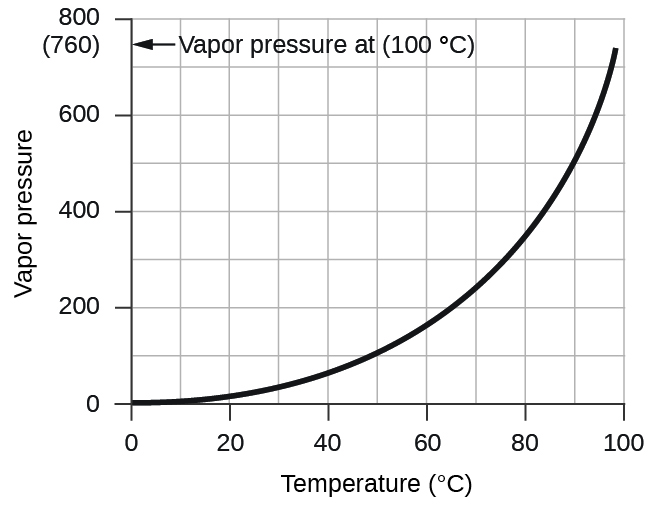
| Temperature (°C) | Force per unit area (torr) | Temperature (°C) | Pressure (torr) | Temperature (°C) | Pressure (torr) | ||
|---|---|---|---|---|---|---|---|
| –x | 1.95 | xviii | 15.5 | thirty | 31.8 | ||
| –v | three.0 | nineteen | sixteen.5 | 35 | 42.2 | ||
| –2 | 3.9 | twenty | 17.v | 40 | 55.iii | ||
| 0 | 4.vi | 21 | xviii.7 | fifty | 92.5 | ||
| 2 | five.3 | 22 | 19.8 | 60 | 149.iv | ||
| 4 | 6.1 | 23 | 21.1 | 70 | 233.seven | ||
| six | vii.0 | 24 | 22.4 | 80 | 355.ane | ||
| 8 | 8.0 | 25 | 23.8 | 90 | 525.viii | ||
| ten | nine.2 | 26 | 25.2 | 95 | 633.9 | ||
| 12 | 10.v | 27 | 26.7 | 99 | 733.2 | ||
| 14 | 12.0 | 28 | 28.3 | 100.0 | 760.0 | ||
| sixteen | 13.6 | 29 | thirty.0 | 101.0 | 787.vi | ||
| Table 2. Vapor Pressure of Ice and H2o in Various Temperatures at Body of water Level | |||||||
Example 6
Pressure of a Gas Nerveless Over Water
If 0.200 L of argon is nerveless over water at a temperature of 26 °C and a pressure level of 750 torr in a system similar that shown in Effigy 3, what is the partial pressure of argon?
Solution
According to Dalton's constabulary, the total pressure in the bottle (750 torr) is the sum of the partial pressure level of argon and the partial pressure of gaseous water:
[latex]P_\text{T} = P_\text{Ar} + P_{{\text{H}_2}\text{O}}[/latex]
Rearranging this equation to solve for the force per unit area of argon gives:
[latex]P_\text{Ar} = P_\text{T} - P_{{\text{H}_2}\text{O}}[/latex]
The pressure level of water vapor above a sample of liquid water at 26 °C is 25.2 torr (Appendix East), so:
[latex]P_\text{Ar} = 750 \;\text{torr} - 25.two \;\text{torr} = 725 \;\text{torr}[/latex]
Check Your Learning
A sample of oxygen collected over water at a temperature of 29.0 °C and a pressure level of 764 torr has a volume of 0.560 L. What book would the dry oxygen have under the same conditions of temperature and pressure level?
Chemical Stoichiometry and Gases
Chemical stoichiometry describes the quantitative relationships between reactants and products in chemical reactions.
We have previously measured quantities of reactants and products using masses for solids and volumes in conjunction with the molarity for solutions; now we can also use gas volumes to indicate quantities. If we know the book, pressure, and temperature of a gas, we can employ the ideal gas equation to calculate how many moles of the gas are present. If we know how many moles of a gas are involved, we tin calculate the volume of a gas at whatever temperature and pressure.
Avogadro'due south Law Revisited
Sometimes we tin can have advantage of a simplifying feature of the stoichiometry of gases that solids and solutions practice non exhibit: All gases that bear witness ideal beliefs contain the same number of molecules in the same book (at the aforementioned temperature and pressure). Thus, the ratios of volumes of gases involved in a chemical reaction are given by the coefficients in the equation for the reaction, provided that the gas volumes are measured at the same temperature and force per unit area.
Nosotros can extend Avogadro'due south law (that the volume of a gas is straight proportional to the number of moles of the gas) to chemical reactions with gases: Gases combine, or react, in definite and simple proportions by book, provided that all gas volumes are measured at the same temperature and pressure. For instance, since nitrogen and hydrogen gases react to produce ammonia gas according to [latex]\text{N}_2(g) + 3\text{H}_2(g) \longrightarrow 2\text{NH}_3(g)[/latex], a given book of nitrogen gas reacts with three times that book of hydrogen gas to produce two times that volume of ammonia gas, if pressure and temperature remain abiding.
The explanation for this is illustrated in Effigy v. According to Avogadro's police force, equal volumes of gaseous Northward2, H2, and NHthree, at the same temperature and pressure level, incorporate the same number of molecules. Considering one molecule of Due north2 reacts with three molecules of H2 to produce two molecules of NH3, the volume of Htwo required is three times the volume of Ntwo, and the volume of NH3 produced is two times the volume of N2.
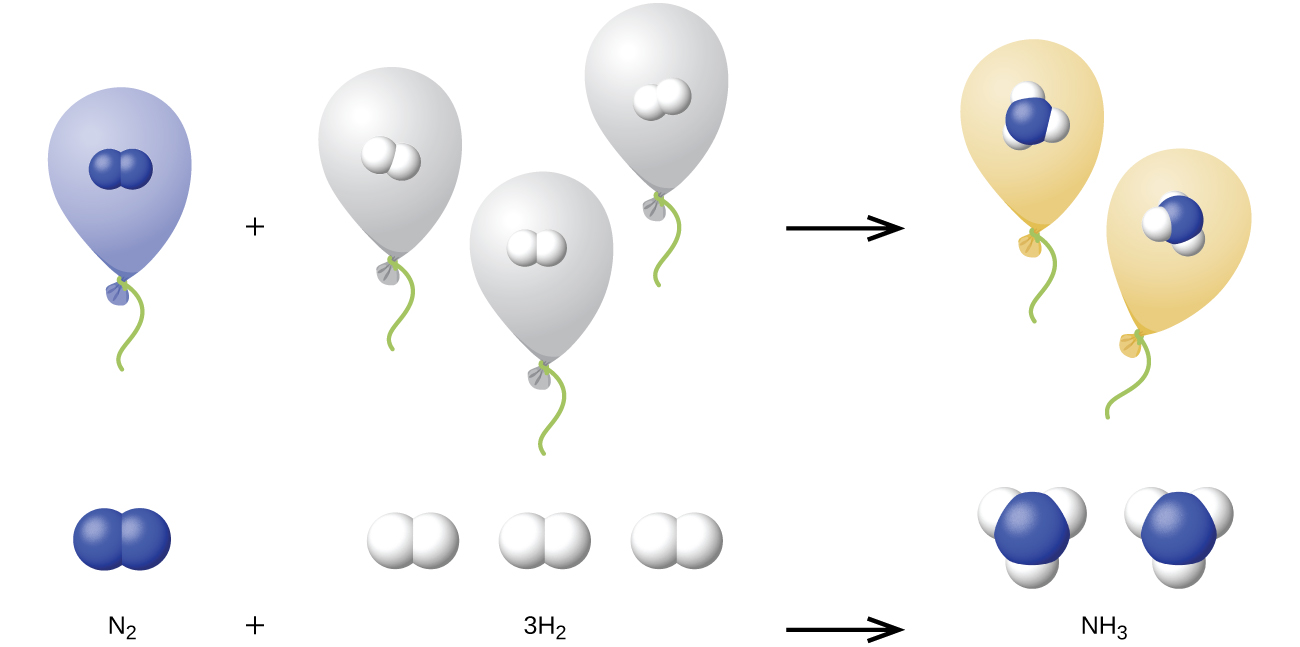
Instance seven
Reaction of Gases
Propane, C3Height(grand), is used in gas grills to provide the heat for cooking. What volume of O2(grand) measured at 25 °C and 760 torr is required to react with 2.7 L of propane measured nether the same conditions of temperature and pressure? Assume that the propane undergoes complete combustion.
Solution
The ratio of the volumes of CiiiH8 and Otwo will be equal to the ratio of their coefficients in the balanced equation for the reaction:
[latex]\begin{assortment}{l c r} \text{C}_3 \text{H}_8(g) + 5\text{O}_2(g) & \longrightarrow & three\text{CO}_2(g) + 4\text{H}_2 \text{O}(l) \\[1em] ane \;\text{volume} + 5 \;\text{volumes} & & 3 \;\text{volumes} + iv \;\text{volumes} \end{array}[/latex]
From the equation, we see that one volume of CiiiH8 will react with five volumes of Oii:
[latex]ii.7 \;\rule[0.75ex]{three.2em}{0.1ex}\hspace{-3.2em}\text{Fifty C}_3 \text{H}_8 \times \frac{5 \;\text{L O}_2}{1 \;\dominion[0.35ex]{ii.5em}{0.1ex}\hspace{-two.5em}\text{L C}_3 \text{H}_8} = 13.5 \;\text{50 O}_2[/latex]
A volume of xiii.five L of Otwo will exist required to react with 2.7 Fifty of C3H8.
Check Your Learning
An acetylene tank for an oxyacetylene welding torch provides 9340 L of acetylene gas, C2H2, at 0 °C and 1 atm. How many tanks of oxygen, each providing 7.00 × 103 L of Oii at 0 °C and 1 atm, volition be required to fire the acetylene?
[latex]2\text{C}_2 \text{H}_2 + five\text{O}_2 \longrightarrow 4\text{CO}_2 + 2\text{H}_2 \text{O}[/latex]
Answer:
3.34 tanks (two.34 × 104 L)
Example 8
Volumes of Reacting Gases
Ammonia is an of import fertilizer and industrial chemical. Suppose that a volume of 683 billion cubic feet of gaseous ammonia, measured at 25 °C and ane atm, was manufactured. What volume of H2(yard), measured under the same weather, was required to prepare this amount of ammonia by reaction with N2?
[latex]\text{Due north}_2(g) + three\text{H}_2(g) \longrightarrow ii\text{NH}_3(g)[/latex]
Solution
Because equal volumes of H2 and NH3 contain equal numbers of molecules and each three molecules of H2 that react produce two molecules of NHthree, the ratio of the volumes of Hii and NH3 volition be equal to 3:ii. Two volumes of NH3, in this instance in units of billion ftiii, volition be formed from three volumes of H2:
[latex]683 \;\rule[0.75ex]{vi.5em}{0.1ex}\hspace{-vi.5em}\text{billion ft}^iii \;\text{NH}_3 \times \frac{three \;\text{billion ft}^three \;\text{H}_2}{ii \;\rule[0.5ex]{4.7em}{0.1ex}\hspace{-4.7em}\text{billion ft}^3 \;\text{NH}_3} = 1.02 \times 10^three \;\text{billion ft}^three \;\text{H}_2[/latex]
The manufacture of 683 billion ft3 of NH3 required 1020 billion ft3 of H2. (At 25 °C and ane atm, this is the volume of a cube with an edge length of approximately ane.9 miles.)
Check Your Learning
What volume of Oii(g) measured at 25 °C and 760 torr is required to react with 17.0 L of ethylene, C2Hfour(g), measured under the same conditions of temperature and pressure? The products are CO2 and water vapor.
Example nine
Volume of Gaseous Product
What volume of hydrogen at 27 °C and 723 torr may be prepared by the reaction of eight.88 g of gallium with an excess of hydrochloric acid?
[latex]2\text{Ga}(s) + half dozen \text{HCl}(aq) \longrightarrow 2\text{GaCl}_3 (aq) + iii\text{H}_2(g)[/latex]
Solution
To convert from the mass of gallium to the book of Hii(chiliad), nosotros need to practice something like this:

The first two conversions are:
[latex]8.88 \;\dominion[0.75ex]{2.5em}{0.1ex}\hspace{-2.5em}\text{k Ga} \times \frac{1 \;\rule[0.5ex]{2.5em}{0.1ex}\hspace{-two.5em}\text{mol Ga}}{69.723 \;\dominion[0.5ex]{ane.5em}{0.1ex}\hspace{-ane.5em}\text{g Ga}} \times \frac{iii \;\text{mol H}_2}{2 \;\rule[0.5ex]{2.5em}{0.1ex}\hspace{-2.5em}\text{mol Ga}} = 0.191 \;\text{mol H}_2[/latex]
Finally, we can use the ideal gas police:
[latex]V_{\text{H}_2} = (\frac{nRT}{P})_{\text{H}_2} = \frac{0.191 \;\rule[0.5ex]{1.25em}{0.1ex}\hspace{-one.25em}\text{mol} \times 0.08206 \;\text{L} \;\rule[0.5ex]{4.5em}{0.1ex}\hspace{-iv.5em}\text{atm mol}^{-1} \text{M}^{-ane} \times 300 \;\text{K}}{0.951 \;\dominion[0.5ex]{1.4em}{0.1ex}\hspace{-one.4em}\text{atm}} = iv.94 \;\text{L}[/latex]
Cheque Your Learning
Sulfur dioxide is an intermediate in the preparation of sulfuric acid. What volume of Thentwo at 343 °C and 1.21 atm is produced by burning fifty.00 kg of sulfur in oxygen?
Greenhouse Gases and Climate change
The thin skin of our atmosphere keeps the earth from being an ice planet and makes it habitable. In fact, this is due to less than 0.5% of the air molecules. Of the energy from the sunday that reaches the earth, almost [latex]\frac{one}{3}[/latex] is reflected back into space, with the residue captivated by the atmosphere and the surface of the globe. Some of the energy that the earth absorbs is re-emitted equally infrared (IR) radiation, a portion of which passes back out through the atmosphere into space. All the same, most of this IR radiation is absorbed past sure substances in the atmosphere, known every bit greenhouse gases, which re-emit this energy in all directions, trapping some of the heat. This maintains favorable living weather condition—without atmosphere, the average global average temperature of 14 °C (57 °F) would be about –xix °C (–ii °F). The major greenhouse gases (GHGs) are h2o vapor, carbon dioxide, marsh gas, and ozone. Since the Industrial Revolution, human activeness has been increasing the concentrations of GHGs, which have changed the free energy balance and are significantly altering the earth's climate (Figure 6).
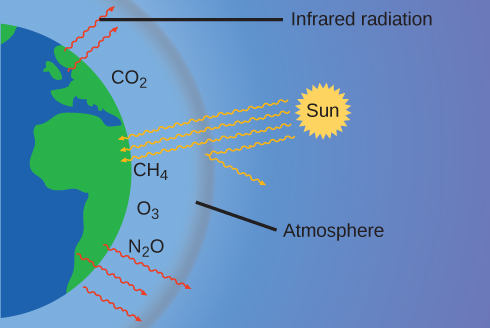
There is strong evidence from multiple sources that higher atmospheric levels of COtwo are acquired by human being action, with fossil fuel burning accounting for most [latex]\frac{3}{4}[/latex] of the recent increase in CO2. Reliable data from ice cores reveals that CO2 concentration in the temper is at the highest level in the past 800,000 years; other bear witness indicates that it may be at its highest level in 20 meg years. In recent years, the CO2 concentration has increased from historical levels of below 300 ppm to almost 400 ppm today (Figure seven).
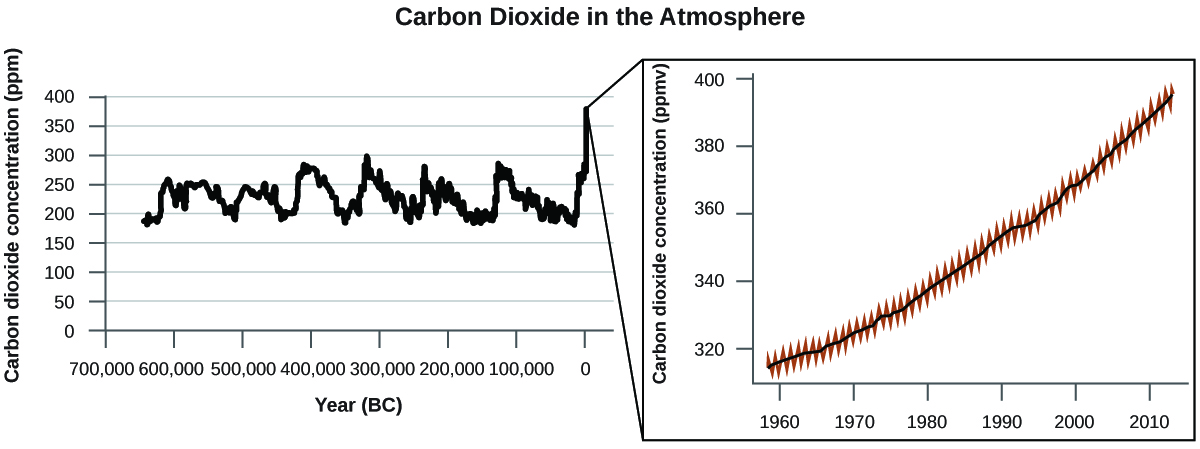

Click here to see a two-infinitesimal video explaining greenhouse gases and global warming.
Susan Solomon
Atmospheric and climate scientist Susan Solomon (Figure eight) is the writer of one of The New York Times books of the year (The Coldest March, 2001), 1 of Time magazine'due south 100 most influential people in the world (2008), and a working group leader of the Intergovernmental Panel on Climate change (IPCC), which was the recipient of the 2007 Nobel Peace Prize. She helped determine and explain the cause of the formation of the ozone hole over Antarctica, and has authored many of import papers on climatic change. She has been awarded the meridian scientific honors in the Us and France (the National Medal of Science and the Grande Medaille, respectively), and is a member of the National Academy of Sciences, the Royal Social club, the French Academy of Sciences, and the European Academy of Sciences. Formerly a professor at the University of Colorado, she is now at MIT, and continues to work at NOAA.
For more than information, watch this video almost Susan Solomon.
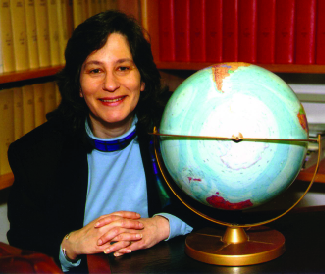
Key Concepts and Summary
The platonic gas law tin can be used to derive a number of convenient equations relating directly measured quantities to properties of involvement for gaseous substances and mixtures. Appropriate rearrangement of the ideal gas equation may be fabricated to allow the adding of gas densities and molar masses. Dalton's law of partial pressures may exist used to chronicle measured gas pressures for gaseous mixtures to their compositions. Avogadro's law may be used in stoichiometric computations for chemical reactions involving gaseous reactants or products.
Key Equations
- [latex]P_{Full} = P_A + P_B + P_C + \cdots = \sum_\text{i} P_\text{i}[/latex]
- [latex]P_A = X_A P_{Full}[/latex]
- [latex]X_A = \frac{n_A}{n_{Total}}[/latex]
Chemistry End of Chapter Exercises
- What is the density of laughing gas, dinitrogen monoxide, NtwoO, at a temperature of 325 One thousand and a pressure level of 113.0 kPa?
- Calculate the density of Freon 12, CFtwoCl2, at 30.0 °C and 0.954 atm.
- Which is denser at the same temperature and pressure, dry out air or air saturated with water vapor? Explain.
- A cylinder of O2(grand) used in breathing by emphysema patients has a volume of 3.00 L at a force per unit area of ten.0 atm. If the temperature of the cylinder is 28.0 °C, what mass of oxygen is in the cylinder?
- What is the molar mass of a gas if 0.0494 grand of the gas occupies a volume of 0.100 L at a temperature 26 °C and a force per unit area of 307 torr?
- What is the molar mass of a gas if 0.281 m of the gas occupies a volume of 125 mL at a temperature 126 °C and a pressure level of 777 torr?
- How could you testify experimentally that the molecular formula of propene is C3Hhalf-dozen, not CHii?
- The density of a certain gaseous fluoride of phosphorus is 3.93 grand/L at STP. Calculate the molar mass of this fluoride and determine its molecular formula.
- Consider this question: What is the molecular formula of a compound that contains 39% C, 45% North, and 16% H if 0.157 g of the compound occupies l25 mL with a force per unit area of 99.five kPa at 22 °C?
(a) Outline the steps necessary to reply the question.
(b) Answer the question.
- A 36.0–Fifty cylinder of a gas used for scale of blood gas analyzers in medical laboratories contains 350 g CO2, 805 g Oii, and 4,880 g North2. At 25 degrees C, what is the pressure level in the cylinder in atmospheres?
- A cylinder of a gas mixture used for scale of blood gas analyzers in medical laboratories contains 5.0% CO2, 12.0% Otwo, and the remainder Northward2 at a full pressure level of 146 atm. What is the fractional pressure of each component of this gas? (The percentages given indicate the percentage of the total pressure that is due to each component.)
- A sample of gas isolated from unrefined petroleum contains 90.0% CH4, eight.9% C2H6, and 1.1% C3H8 at a total pressure of 307.ii kPa. What is the fractional pressure of each component of this gas? (The percentages given point the pct of the total pressure that is due to each component.)
- A mixture of 0.200 one thousand of H2, 1.00 grand of Nii, and 0.820 m of Ar is stored in a closed container at STP. Find the volume of the container, assuming that the gases showroom ideal beliefs.
- Virtually mixtures of hydrogen gas with oxygen gas are explosive. Even so, a mixture that contains less than three.0 % O2 is non. If enough O2 is added to a cylinder of H2 at 33.2 atm to bring the total pressure to 34.five atm, is the mixture explosive?
- A commercial mercury vapor analyzer can detect, in air, concentrations of gaseous Hg atoms (which are poisonous) as low equally 2 × x−6 mg/50 of air. At this concentration, what is the partial pressure of gaseous mercury if the atmospheric pressure is 733 torr at 26 °C?
- A sample of carbon monoxide was collected over water at a total pressure of 756 torr and a temperature of xviii °C. What is the pressure of the carbon monoxide? (See Tabular array 2 for the vapor pressure level of water.)
- In an experiment in a full general chemistry laboratory, a student collected a sample of a gas over water. The volume of the gas was 265 mL at a pressure of 753 torr and a temperature of 27 °C. The mass of the gas was 0.472 thou. What was the molar mass of the gas?
- Joseph Priestley showtime prepared pure oxygen by heating mercuric oxide, HgO:
[latex]2 \text{HgO}(due south) \longrightarrow two\text{Hg}(50) + \text{O}_2(g)[/latex](a) Outline the steps necessary to respond the post-obit question: What volume of O2 at 23 °C and 0.975 atm is produced by the decomposition of 5.36 yard of HgO?
(b) Answer the question.
- Cavendish prepared hydrogen in 1766 by the novel method of passing steam through a red-hot gun butt:
[latex]iv \text{H}_2 \text{O}(g) + 3\text{Fe}(s) \longrightarrow \text{Atomic number 26}_3 \text{O}_4 + 4\text{H}_2(g)[/latex](a) Outline the steps necessary to answer the following question: What book of Htwo at a pressure level of 745 torr and a temperature of xx °C tin can be prepared from the reaction of 15.O g of H2O?
(b) Answer the question.
- The chlorofluorocarbon CCltwoF2 can be recycled into a different compound by reaction with hydrogen to produce CH2Fii(1000), a compound useful in chemical manufacturing:
[latex]\text{CCl}_2 \text{F}_2(grand) + 4 \text{H}_2(thousand) \longrightarrow \text{CH}_2 \text{F}_2(m) + two\text{HCl}(thou)[/latex]
(a) Outline the steps necessary to answer the following question: What volume of hydrogen at 225 atm and 35.5 °C would be required to react with ane ton (ane.000 × 10iii kg) of CCliiF2?(b) Answer the question.
- Machine air bags are inflated with nitrogen gas, which is formed by the decomposition of solid sodium azide (NaN3). The other product is sodium metal. Summate the book of nitrogen gas at 27 °C and 756 torr formed past the decomposition of 125 one thousand of sodium azide.
- Lime, CaO, is produced by heating calcium carbonate, CaCO3; carbon dioxide is the other production.
(a) Outline the steps necessary to respond the following question: What book of carbon dioxide at 875° and 0.966 atm is produced by the decomposition of one ton (one.000 × ten3 kg) of calcium carbonate?
(b) Answer the question.
- Before pocket-sized batteries were bachelor, carbide lamps were used for wheel lights. Acetylene gas, CtwoHii, and solid calcium hydroxide were formed by the reaction of calcium carbide, CaCtwo, with water. The ignition of the acetylene gas provided the light. Currently, the same lamps are used by some cavers, and calcium carbide is used to produce acetylene for carbide cannons.
(a) Outline the steps necessary to answer the post-obit question: What volume of C2Hii at one.005 atm and 12.2 °C is formed by the reaction of xv.48 g of CaC2 with h2o?
(b) Reply the question.
- Summate the volume of oxygen required to burn 12.00 L of ethane gas, C2H6, to produce carbon dioxide and water, if the volumes of C2Hhalf-dozen and Otwo are measured under the same conditions of temperature and pressure.
- What volume of O2 at STP is required to oxidize eight.0 L of NO at STP to NO2? What volume of NOii is produced at STP?
- Consider the following questions:
(a) What is the total volume of the COii(1000) and H2O(g) at 600 °C and 0.888 atm produced past the combustion of 1.00 Fifty of CtwoHsix(grand) measured at STP?
(b) What is the partial pressure of H2O in the product gases?
- Methanol, CHiiiOH, is produced industrially past the following reaction:[latex]\text{CO}(yard) + 2 \text{H}_2(chiliad) \xrightarrow{\;\;\;\;\;\;\text{copper catalyst} \;300 \;^{\circ} \text{C},\;300 \;\text{atm}\;\;\;\;\;\;} \text{CH}_3 \text{OH}(g)[/latex]
Assuming that the gases deport every bit platonic gases, find the ratio of the full volume of the reactants to the final volume. - What book of oxygen at 423.0 Grand and a pressure of 127.4 kPa is produced past the decomposition of 129.7 g of BaO2 to BaO and Otwo?
- A two.l-L sample of a colorless gas at STP decomposed to requite 2.50 L of Northwardtwo and 1.25 L of Otwo at STP. What is the colorless gas?
- Ethanol, CtwoHfiveOH, is produced industrially from ethylene, C2Hiv, past the following sequence of reactions:
[latex]3 \text{C}_2 \text{H}_4 + 2\text{H}_2 \text{And so}_4 \longrightarrow \text{C}_2 \text{H}_5 \text{HSO}_4 + (\text{C}_2 \text{H}_5)_2 \text{And then}_4[/latex]
[latex]\text{C}_2 \text{H}_5 \text{HSO}_4 + (\text{C}_2 \text{H}_5)_2 \text{And then}_4 + 3\text{H}_2 \text{O} \longrightarrow 3\text{C}_2 \text{H}_5 \text{OH} + 2\text{H}_2 \text{And then}_4[/latex]
What book of ethylene at STP is required to produce 1.000 metric ton (g kg) of ethanol if the overall yield of ethanol is xc.i%? - One molecule of hemoglobin will combine with four molecules of oxygen. If 1.0 k of hemoglobin combines with 1.53 mL of oxygen at trunk temperature (37 °C) and a pressure of 743 torr, what is the molar mass of hemoglobin?
- A sample of a chemical compound of xenon and fluorine was confined in a bulb with a pressure of 18 torr. Hydrogen was added to the seedling until the pressure was 72 torr. Passage of an electrical spark through the mixture produced Xe and HF. Subsequently the HF was removed past reaction with solid KOH, the final pressure of xenon and unreacted hydrogen in the bulb was 36 torr. What is the empirical formula of the xenon fluoride in the original sample? (Note: Xenon fluorides incorporate only one xenon atom per molecule.)
- One method of analyzing amino acids is the van Slyke method. The characteristic amino groups (−NHtwo) in protein material are allowed to react with nitrous acid, HNO2, to form Due northtwo gas. From the volume of the gas, the amount of amino acid can be adamant. A 0.0604-g sample of a biological sample containing glycine, CH2(NH2)COOH, was analyzed by the van Slyke method and yielded iii.70 mL of North2 nerveless over water at a pressure level of 735 torr and 29 °C. What was the per centum of glycine in the sample?
[latex]\text{CH}_2 \; (\text{NH}_2) \text{CO}_2 \text{H} + \text{HNO}_2 \longrightarrow \text{CH}_2 \;(\text{OH}) \text{CO}_2 \text{H} + \text{H}_2 \text{O} + \text{N}_2[/latex]
Glossary
- Dalton's law of partial pressures
- total pressure level of a mixture of ideal gases is equal to the sum of the partial pressures of the component gases.
- mole fraction (X)
- concentration unit defined every bit the ratio of the molar amount of a mixture component to the full number of moles of all mixture components
- partial pressure
- force per unit area exerted past an individual gas in a mixture
- vapor pressure level of water
- pressure level exerted past h2o vapor in equilibrium with liquid h2o in a closed container at a specific temperature
Solutions
Answers to Chemistry Stop of Chapter Exercises
2. 4.64 g L−ane
four. 38.8 g
half dozen. 72.0 thou mol−1
8. 88.1 g mol−1; PF3
10. 141 atm
12. CH4: 276 kPa; C2Hhalf dozen: 27 kPa; C3Height: 3.4 kPa
fourteen. Yes
16. 740 torr
18. (a) Make up one's mind the moles of HgO that decompose; using the chemical equation, determine the moles of Oii produced by decomposition of this amount of HgO; and determine the book of O2 from the moles of O2, temperature, and pressure. (b) 0.308 Fifty
20. (a) Determine the tooth mass of CCl2Fii. From the balanced equation, calculate the moles of H2 needed for the complete reaction. From the ideal gas constabulary, convert moles of H2 into volume. (b) 3.72 × 103 Fifty
22. (a) Balance the equation. Determine the grams of CO2 produced and the number of moles. From the platonic gas law, determine the volume of gas. (b) seven.43 × 105 L
24. 42.00 L
26. (a) xviii.0 L; (b) 0.533 atm
28. 10.57 L O2
30. 5.xl × 10v L
32. XeF2
Source: https://opentextbc.ca/chemistry/chapter/9-3-stoichiometry-of-gaseous-substances-mixtures-and-reactions/
0 Response to "Chegg What Is the Major Product Formed in the Following Reaction Again Assuming No Rearrangements"
Post a Comment